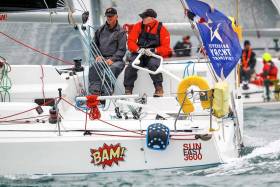Displaying items by tag: Simon Knowles
Most offshore sailors would be well pleased to have notched their season’s start with a win in April, but Howth’s Simon Knowles goes into May with two bullets already in the bag for the J/109 Indian in the first races of the ISORA Viking Marine 2024 programme.
Curiously enough, although he was frustrated by unseasonably flukey and sometimes non-existent winds in his February challenge with a chartered J/122 in the RORC Caribbean 600, he says he likes the concentration challenge of light wind racing provided it’s on a reasonably level playing field. And he certainly has demonstrated his expertise in the soft going, with several established and new contenders left in Indian’s wake.
Howth Crew Fogerty & Knowles Battle For Top Two-Handed Place In RB&I
#RB&I - Conor Fogerty and Simon Knowles in the Sunfast 3600 BAM! were yesterday evening narrowly leading the two-handed division in the RORC Sevenstar Round Britain & Ireland’s 1,805-mile marathon, writes W M Nixon.
The Howth Yacht Club duo were trying to keep cover on the Figaro 2 El Velosolex SL Energies Group (Bejamin Schwartz & Chen Jin Hao) close to the north of them, and Sunfast 3600 sister-ship Game On (Ian Hoddle & Ollie Wyatt) to their southeast as the fleet approached the massive tidal gate of Portland Bill, sailing hard on the wind.
El Velsolex to the north found freshening breeze in under Portland Island, which also got her more quickly into the Bill’s beneficial tidal shadow.
With the local sharpening of the breeze, she was able to make a clinical of job of rounding Portland Bill within a stone’s throw of the shore in slacker water, and then lengthening away into Lyme Bay on port tack.
This left BAM! with the least bad option of following, and though she too was right in on the shore at the point itself, the spark had gone from the breeze and for a while she was hung up at only 2.2 knots over the ground.
El Velosolex, meanwhile, got away into a lead of thee miles before the Irish boat got going again, but at least Game On had been left well astern, so much so that she opted to go well offshore.
Any beat westward in the English Channel will find a varying pattern of wind strengths, and through the night as the fleet slowly neared Start Point with the Mach 40.3 Corum (Nicolas Troussel) leading narrowly on the water from Phil Sharp’s Class 40 Imerys Clean Energy, at times those inshore were favoured.
But then those offshore began to get better breezes, and when the group to the north closed with the southerly group off Start Point around 7am this morning, El Velosolex had lengthened further to eight miles ahead of BAM!, but the latter was now neck-and-neck with Game On.
The two Sunfast 3600s — less than two miles apart — elected to continue the offshore tack on starboard, but at 10.29am El Velosolex tacked onto port.
This was the state of affairs at the noon position, with the Figaro still heading for the distant shore, while Game On and BAM! are holding on starboard and having a right dong, Game On ahead by 1.7 sea miles and sailing at 6.3 knots, and Bam! on her weather quarter shown as sailing at 6.4 knots. And they still have 1,670 miles to go.
Crossing the Celtic Sea from the Isles of Scilly to southwest Ireland will be interesting, as the wind is forecast to be bang on the nose at first, but backing through tomorrow. This suggests that keeping to the left will be a strategic imperative, but for how long will be anyone’s guess.
Race Tracker here: http://yb.tl/rbni2018
























































